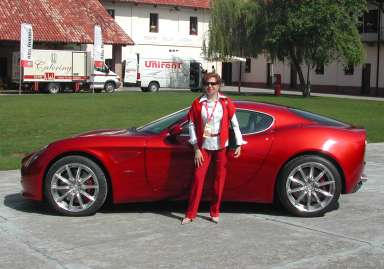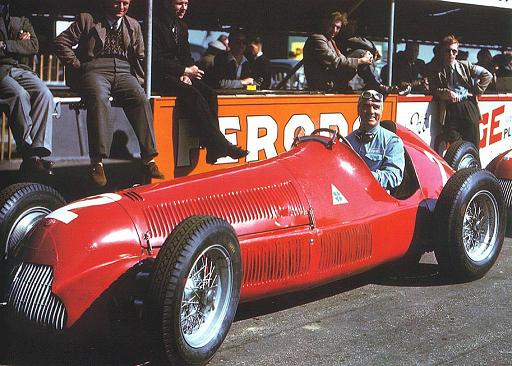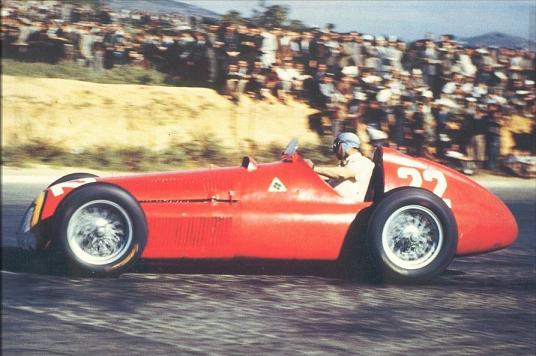|
|
| Utenti on-line |
1255 |
Utenti iscritti al web |
6435 |
Accessi di oggi |
273 |
|

|
The History of Alfa Romeo
(by Elvira Ruocco)
Article 1
|
“158”
and “159”, the Biscione’s unbeatables
In 1950 the Formula 1 World
Championship sees Alfa Romeos
triumph on the circuits all over
the world. Nino Farina is the
first racing car driver to be
crowned World Champion. His
fellow and rival Juan Manuel
Fangio prevails in 1951
The fabulous Alfettas (little
Alfas) occupy a very first-rate
position in motor racing history.
From 1938 to 1951, with
exception of the stop due to the
war period, they have dominated
on every track worldwide. No
other racing car has had a so
long lifetime and perhaps no
other car has ever ended
undefeated any sport season.
The 158 signature meant the
engine capacity (1.5 litres) and
the number of cylinders (8). It
had been designed by Gioacchino
Colombo in Modena and started
its career under the badge of
the new “Alfa Corse” sport
organization run by Enzo Ferrari,
on August 7, 1938 at the Circuit
of the Montenero (Livorno) where
it won the 1st and 2nd place in
absolute ranking.
The first period of achievements
in races of this car ended with
the 1940 Tripoli G.P., owing to
the world conflict that forced
to an almost complete standstill
in competitive activities. The
Alfettas and the developmental
cars were secured; those thin
red fireballs constituted a
technical heritage of
inestimable value.
By the renewal of competitions
in 1946, changes were made to
the engine which raised power to
255 HP from the 225 HP of 1940.
The Experiment Service, headed
by eng. Gian Paolo Garcea, was
responsible for the preparation
and race assistance of this
monoposto, which, after the
overwhelming victory (first
three absolute placings) at the
Nations’ Grand Prix that took
place in Geneva on June 21,
1946, was called by the press:
“the symbol of recovery of
our country”; “the superb
affirmation of the Italian
industry”; “first in the ranking
of the world racing car
production.” In 1950 the
F.I.A.’s International Sport
Committee organized the first
edition of the Drivers World
Championships, a racing series
devoted to formula one cars,
that is cars with a supercharged
1500 cc engine capacity or up to
4500 cc without compressor. It
was an exciting news because
never till then a world title
had been assigned to individual
drivers. There had been a world
constructors title, but one had
to go back to 1925, when Alfa
Romeo won with the P2.
It was immediately clear that it
was a new outstanding
springboard for car industry, a
top-level championship that
would have produced
unforgettable names and rankings.
But it also became a territory
for a new Italian challenge: the
red Alfas against the red
Ferraris. A duel that led back
the Italian technics to the peak
of world values, giving back, as
in Nuvolari’s times, sense and
colour to the motoring sport of
the second postwar period.
After the threefold victory in
the 1947’s Grand Prix of Belgium
with the Alfettas of Wimille,
Varzi and Trossi at the top of
the results, a French journalist
wrote: “…it looks like we
were gone back by 22 years when,
right here in Spa, the Alfa
Romeo P2s of Ascari e Campari
made a pit stop and the drivers,
sitting at table, had a snack,
so large was their advantage on
opponents”.
1950 was a triumphant year for
the Alfetta: 11 absolute
victories out of 11 Grand Prix,
which lead Alfa Romeo to the
victory in the Formula One World
Championship, a triumph
celebrated in Monza where
Giuseppe Farina crowned World
Champion. In the second place
ranked Juan Manuel Fangio, the
Argentinian racing car driver of
Italian extraction, enlisted by
Alfa Romeo for its return to the
competitions.
Farina on the 158:

In 1951, the Alfettas, on which
relevant improvements were made,
were introduced with the new
“159” designation. The engine,
after the fitting of the
two-stage fuel system, gave 425
HP at 9300 rpm on the dyno. The
chassis had been reinforced, the
rear axle replaced by the De
Dion type solution, the fuel
tanks enlarged to reach a
250-litre capacity and the body
had been slightly widened to
hold the dynamic intake and the
tanks.
People in the Alfa’s pits were
renowned owing to their
refuelling speed: the mechanics
were able to change a full set
of tyres and to refill the tank
in 22 seconds. During such
in-race refuelling, the
mechanics threw a rubber cloak
on the driver in order to
protect him from possible sudden
blazes or from dangerous fuel
spurts. Unlike Ferraris, the
Alfettas needed a larger number
of refuellings since provided
with a supercharged engine.
The Alfetta 159 went along the
previous year stages again, by
confirming its best performances
both on fast circuits and on
mixed-course ones and closed its
sport year by triumphing at the
Barcellona Grand Prix where it
seized its second Workd
Championship with Juan Manuel
Fangio.
Fangio on the 159:

This was the two-year period in
which the first postwar Formula
One was applied, which had a
peculiar feature. Right at the
end of 1951, the two technical
solutions proposed by the
formula for the engines,
supercharged or not, found their
full development, after
legendary sport battles fought
by machines and men of an
incomparable driving style, like
Farina and Fangio who were
fellow and rivals.
By winning the Italian Grand
Prix at Monza which consecrated
him world champion,
Giuseppe
Farina (“Nino”)
realized an old dream to attain
a success on the circuit that
counts the greater sport
tradition and to add his name to
those of Campari, Nuvolari,
Varzi, Fagioli, Stuck, Rosemayer
and Caracciola in the golden
roll of honour.
Born in Turin on October 30,
1906, he nourished a passion for
cars and races ever since he was
a child. He used to be brought
to school by a chauffeur with
the small Type 0 Fiat and, by
disobeying father’s orders,
sometimes he persuaded the
chauffeur to give him up the
wheel for some short tract. That
was his first driving school.
Later, in the coachbuilding
works of his father in Tortona
Avenue, with the help of his
brother, he succeeded on Sundays
to set up a track on which they
were running for hours on the
small “Temperino”. He carried
out his first race as mechanic
for his uncle Pinin Farina. He
officially started his career as
driver indeed in the summer of
1930, in a hillclimb race: the
Aosta-Gran San Bernardo. However
the Alfa 1500 went off the road
and Farina suffered severe
fractures which kept him away
from competitions for some years.
He became Italian champion in
1937 after having raced at the
wheel of several cars showing a
great determination and
exceptional endowments of
bravery. For him each race was a
challenge which he absolutely
had to win: the car had to be
always exploited to the highest
degree.
He also found the time to
graduate. This added some touch
to his already relevant
personality and brought him the
nickname of “flying doctor”. His
talents were noticed by Enzo
Ferrari who appointed him a
member of the Alfa Romeo team
and, when Nuvolari left Alfa and
passed to Auto Union, became the
first driver of the Milan House
in an automatic way.
After the second world war, he
resumed racing and, in 1950,
found himself in Alfa in company
of Fangio and Fagioli making up
the team that was called of the
“3 F”.
He was also nicknamed “the lord
of speed” owing to his composed
expression when he was driving,
without any effort. He was shy,
the most shy of all the ace
drivers and the shyness complex
was maybe the only reason for
unhappiness in his life. His
hobby was collecting stamps and
used to spend whole evenings in
his study to stick those tiny
paper squares.
When Alfa Romeo decided to give
up racing at the end of season
’51, he stepped down embittered
by complaining about the fact
that his past had not adequately
been acknowledged.
It has always been spoken,
wrongly, very little of such
great champion, either when he
was winning, either after the
road accident which costs him
his life, in 1966, near Chambery,
when he crashed into a pole at
the wheel of his Lotus Cortina.
Perhaps because such his manners
of publicity-averse gentleman
were not very suited to the
racing world and its followers.
Juan Manuel
Fangio (“el Chueco”)
was born in Balcarce (Buenos
Aires) on June 24, 1911. He
disdained the farmland way of
life and began to work as
mechanic by taking part in some
races. He broke such activity to
enter the artillery school and,
upon his return to Balcarce, he
created a car servicing firm:
the “Fangio, Duffart and
Cavallotti”. In 1934, he took
part in his first race aboard a
Ford with which he intensified
his racing business. In 1940 and
1941, he was Argentinian
national champion, since he won
long and tough competitions like
the classical “Carreras”. In the
postwar period, the victories in
Rio, Buenos Aires, Montevideo
and Rosario brought him the
popularity of an idol. In 1950,
he was enlisted by Alfa Romeo
and entered the lists of the
first Formula One world
championship. He finished as the
runner-up, behind Farina, but,
in his memories, that was the
most beautiful season of his
racing life, even though the
title, which he would have won a
good five times, slipped from
his hands by a hair’s breadth.
He did not know then that he
would have become a great
champion, a “master” for his
driving style. The fact that
Alfa had called him in its
racing team was: “as when an
opera singer is called for the
first time at the LaScala
theatre.” Often, he made use
of musical analogies speaking
about Alfa. He said that the
engine of his Alfetta had
reached the perfection of a
symphony and that he was feeling
as a “violinist who drives
his bow on the strings of a
Stradivari.”
The press did not comment very
positively on his agreement with
Alfa Romeo. Many people wondered
why the Milan House had
appointed a foreign driver. The
truth was that Alfa did not make
questions of local pride but
just had asked for the best ones.
It was maybe in order to dampen
the controversy that the general
manager, eng. Antonio Alessio,
after the first Fangio’s victory
in Sanremo, delivered this
speech at the Argentinian radio:
“I am glad to bring the Alfa
Romeo’s greetings to the
Argentinian sports devotees in
the day in which your champion
Manuel Fangio takes over for the
first time the wheel of our cars
on the Europe’s racetracks. This
alliance between the great
Argentinian driver and the
Italian vanguard car production
yet passes over the sports and
mechanics event to reassert,
across the oceans that though
less than ever divide us, the
indissoluble bond of fraternity
between our two peoples.
And thinking about Manuel
Fangio’s origins, I am proud
that it is up to a son of
Italians, expressed by your
generous land, to defend in
Europe the colours of Alfa
Romeo, worldwide forerunner of
the Italian work. From the
enchanting Italian Riviera which
was the birthplace of whom first
marked the ways towards the new
Americas, and from which so many
children of ours left to
impregnate of their work your
land, I wish that, in this
joyful hour of omens and
victorious promises, goes the
greeting of Alfa Romeo to the
glorious Argentinian Nation.”
In every race of such two sport
years that saw him Farina’s
opponent, there were important,
more or less unusual and also
controversial aspects. While the
first world championship was
taking place, the Italian press
pointed to Fangio as possible
winner but talked at length to
demonstrate that it would not
have been impossible for Farina
to outdo the Argentinian ace, by
underlining that the victory of
an Italian champion would have
been “morally legitimate’’,
since Alfa Romeos were cars made
in Italy. The Argentinian and
European newspapers did not
share the same opinion and were
showing, with results at hand,
that Fangio would have won. It
was also insinuated that, since
the public opinion claimed an
Italian winner, the Alfa’s sport
management would have had
recourse to some stratagem to
grant the Italian supporters’
requests.
Farina won and deservedly won
because no trick can let anyone
devoid of talent and merit turn
champion.
Fangio got his revenge on
October 28, 1952 on the circuit
of Pena Rhin in Barcelona.
“Campeon del Mundo!” shouted
three hundred thousand
spectators to his lap of honours.
They hailed him in Spanish, his
mother tongue, and he felt home.
It was a unforgettable day that
closed between “olè”s, mantillas
and toreadors of Barcelona.
In 1952, as he could not have
the Alfetta 159 any longer owing
to the Alfa’s withdrawal from
races, Fangio signed two
contracts that bounded him to
B.R.M. and Maserati for Formula
1 and 2 racing even though he
stood faithful to the Biscione’s
House for racing in the sport
and touring categories. In 1958,
he hung up his helmet and
goggles, in the incredulity of
the world of racing.
The attainment of two world
championships in a row was the
cause of joy and big pride for
every workmen of the Portello;
not only for the technicians and
mechanics who had indefatigably
worked close to drivers but also
for the others, who only had
seen the big ash grey trucks
leave the Traiano Street’s plant.
Such double shot in world
championships seemed sufficient
to Alfa to (provisionally) close
down the Grand Prix business,
but it continued to keep its
sport image going by taking part
to competitions which are
reminiscent of production cars.
Elvira Ruocco
Copyright Information and Credits
All the multimedia materials and the texts present in this page cannot be reproduced in any way
without the explicit permit of authors and/or owners of the contents. In particular, this applies
with reference to texts and pictures of Ms. Elvira Ruocco
and of the Alfa Romeo Historic Archive
who explicitly authorized the AlfaSport Club for publication.
Translation by Fabio Grandi
|
|
|
|
|

